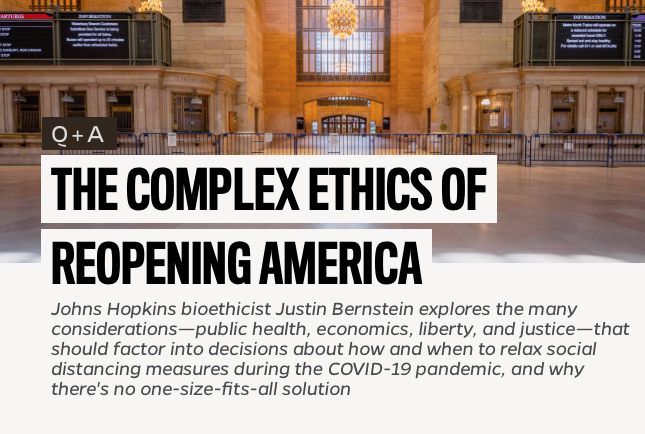The final step in the framework requires decision-makers to reflect on the results from Steps 1-6 to determine which set of policies should be implemented. Taking into account the full set of potential benefits and burdens, their distribution across groups, liberty concerns, legitimacy concerns, along with feasible remedies, which set of policies is most justifiable all things considered?
Some ethics frameworks structure this “all-things-considered” question as a matter of balancing the four kinds of considerations we’ve been considering: well-being, liberty, justice, and legitimacy. A policy is ethically justifiable if it strikes a reasonable balance between well-being (how the policy promotes or undermines the well-being of individuals and groups), respect for liberty (how the policy limits various freedoms or violates privacy), justice (whether the benefits of the policy are fairly distributed, and whether the policy exacerbates or remedies background injustice), and legitimacy (whether the policymaking process has been inclusive, adequately informed by experts and citizen perspectives, with credible communication, and appropriate restraint in enforcement). If a policy burdens some groups more than others in an unfair way, this unfairness must be justifiable in light of the overall benefits achieved by the policy. Similarly, if a policy infringes on individuals’ liberty, this must also be justifiable in light of the overall benefits achieved by the policy.
When assessing a public health policy, the key question is often this: are the public health benefits of the policy (usually the only aspect of well-being under consideration) significant enough to justify any infringements on individual liberties and any respects in which the policy is unfair?
But in the context of this pandemic, the “all things considered” judgment is far more complicated than is typically the case in public health. At stake are multiple dimensions of well-being, not just health, engaging different liberty interests, affecting different groups of people differentially, with significant implications for how we function as a society, both now and in the future. The key issue is which sets of policies will protect and promote our collective well-being, understood broadly to be inclusive of all these complex interests and rights. For example: will maintaining some social distancing policies for another four weeks increase the collective well-being in our state, given the significant harms associated with these policies and the significant uncertainty about the magnitude of the public health benefits? At what point does maintaining social distancing policies undermine our collective well-being, even if it reduces COVID-19 mortality? Some worry that maintaining social distancing policies could be so harmful as to undermine the flourishing of society—for example, by causing economic carnage that cannot be reversed or adequately mitigated by relief bills and future policy efforts. Others worry that a rush to eliminate social distancing policies without appropriate safeguards and brakes risks too much, not only in terms of COVID illness and disease but also in terms of the continued disproportionate impact on our most disadvantaged communities. Subjecting both these frames to more detailed ethical analysis invites us to test our ethical reactions against conceptions of what it means for American society to flourish and our conceptions of our common good.
In light of this, how should policymakers go about reaching an all-things-considered judgment about whether policies are justifiable? Using the information gained in Steps 1-6, we suggest that decision-makers consider the following set of questions about each plan or set of policies:
- Has the public been given adequate opportunity to contribute to identification of policy options and policy design? If not, would it make sense to delay a decision to provide more opportunity for public input?
- Has an adequate range of experts and constituencies been consulted? If not, would it make sense to delay a decision to provide more opportunity for public input?
- Is it plausible that the policies under consideration would promote overall collective well-being as you understand it?
- Do the policies under consideration strike a reasonable balance between saving the most lives during the current pandemic and protecting the broader flourishing of society and promoting the common-good longer-term?
- Do the policies under consideration strike a reasonable balance between preventing deaths from COVID-19 and protecting economic opportunity?
- Is the set of policies unfair to certain groups, and is this reason enough to reject it? Or is even significant unfairness justifiable, given the potential magnitude of the benefits?
- If the policies under consideration restrict individual liberty or privacy, is this justifiable given the potential magnitude of the benefit? Social distancing measures severely restrict liberty; is this justifiable given the potential magnitude of the public health benefit achieved (i.e., the high number of lives that might be saved)? Using cell phone data to track people raises privacy concerns; is this justifiable because it will allow us to ease up on social distancing measures sooner and thereby have significant economic and other benefits?
- What might be the long-lasting effects of the policies on our norms and expectations of government, and the long-lasting effects on our political system? Are these effects acceptable?
At the end of this exercise, we suggest attempting to structure a sentence or paragraph of the following form, filling in the details about the plan you’re recommending: “Despite drawbacks a, b, and c, implementing Policy X at time T has the best chance of striking a reasonable balance of ethical considerations x, y, and z, because of its positive features 1, 2, and 3.” This kind of clear articulation of the ethical justification for a policy can be useful when communicating with the public—and the public is owed this kind of justification.
